UPS outlines what it has learned from deploying electric vans in central London – and why smart charging could be key to electrifying transport. Brendan Coyne reports
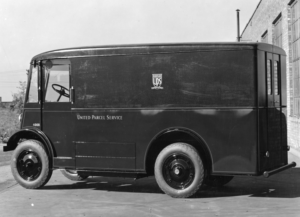 UPS first trialled electric vehicles in New York in 1930. The technology has moved on somewhat, yet in 2019, decarbonising a delivery fleet at scale remains a complex challenge with many moving parts.
UPS first trialled electric vehicles in New York in 1930. The technology has moved on somewhat, yet in 2019, decarbonising a delivery fleet at scale remains a complex challenge with many moving parts.
In Europe, UPS revisited electric vans in 2008, with six of 12 ordered from manufacturer MODEC destined for London. But MODEC soon stopped producing them due to lack of demand. That led UPS to convert some of its diesel vehicles, sending them to Germany to be refitted.
Currently, UPS has more than 300 EVs deployed in Europe and the U.S., with 65 stationed at its Camden base. With a range of 50-60 miles a day, UPS is using the knowledge it is gaining at Camden to inform the next phases of its strategy.
Infrastructure challenge
 One of the first lessons learned was that the associated electrical infrastructure is a key challenge, says Claire Thompson-Sage, sustainable development co-ordinator at UPS.
One of the first lessons learned was that the associated electrical infrastructure is a key challenge, says Claire Thompson-Sage, sustainable development co-ordinator at UPS.
Ensuring the site had sufficient power capacity necessitated a substantial grid upgrade – and one that came with caveats.
“Where the substation was outside of our leased area, the landlord did not want responsibility for maintaining supply if we ever moved out,” explains Thompson-Sage. “So “We had to agree that we would pay to strip it all back should that eventuate. In terms of financing, it was a tricky situation.”
Smart charging
Hence when seeking to further electrify the central London fleet (UPS ultimately hopes to go all electric with 170 central London vans), it sought a different approach.
Working with UK Power Networks and Cross River Partnership, via a project part-funded by OLEV, the consortium has developed a smart grid system. It uses battery storage, network monitoring and smart controls to accommodate vehicle charging at the site – which would otherwise have required an expensive grid upgrade (see boxout below).
While the system currently uses new batteries, UPS ultimately hopes to use batteries from its current electric fleet as they approach end of life.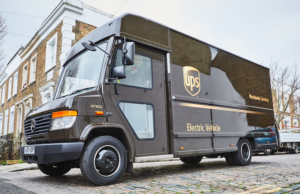
UPS is also exploring the option of exporting power generated from solar PV into battery storage systems at its London Gateway Facility – and while the Camden base does not have PV, UPS is “exploring that option”, says Thompson-Sage.
Smart benefits
At Camden, where smart charging has been in place since April 2017, it has been “hugely beneficial”, says Thompson-Sage. The system interrogates battery state and charges each accordingly, giving only as much as each battery requires. Because it is designed for full electrification of the fleet, and the site is not yet at capacity, it can charge later at night, says Thompson-Sage, when electricity is cheaper.
“So we are paying less for electricity via the smart system and it has also helped with maintenance,” she explains. “If a vehicle is not charging at the rate it should be, that is a warning sign that something might not be right, such as faulty cables.”
Practical challenges: Maintenance
Any change of system throws up challenges. But Thompson-Sage says practical aspects should not be overlooked.
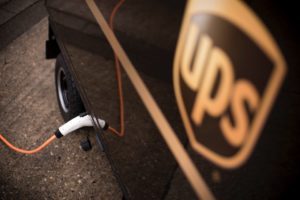 “Probably the biggest unexpected item was damage to cables,” she says. “Vehicle maintenance is cheaper – but with so many vehicles charging in one depot, it was easy for loose cables to get damaged.”
“Probably the biggest unexpected item was damage to cables,” she says. “Vehicle maintenance is cheaper – but with so many vehicles charging in one depot, it was easy for loose cables to get damaged.”
Thompson-Sage says UPS is now looking into wireless charging infrastructure.
“Wireless wasn’t available in 2008 [when UPS first trialled electric vans at Camden]. Although it is more expensive upfront and there are some losses, there is less kit to maintain – so wireless charging could be a more cost-effective option overall.”
Maintenance may also become a challenge as more companies switch to EVs.
“One thing that gets overlooked is the availability of mechanics and engineers: If there is an influx of electric vehicles to maintain, do we have the trained mechanics to service them? If there is a shortage, labour costs will increase,” says Thompson-Sage. “That is a very important issue, but one that gets missed.”
Practical challenge: Planning ahead
If the company is to deliver on its ambitious decarbonisation goals, it will need to expand electric or alternative-fuelled vehicles outside of London.
Planning a major logistics operation on limited range must account for many variables, says Thompson-Sage.
“Currently, a lot of the electric vans are limited to around 50 miles a day. We need to identify routes that could be undertaken by an EV, then factor in the current power availability at each of those buildings and how many vehicles could be charged without the need for a grid upgrade,” she explains.
Looking first at cities that are implementing clean air zones helps focus that activity, says Thompson-Sage, but throws further elements into the equation.
“You have to consider the size of the clean air zone and how it is implemented,” she says, with certain cities planning blanket implementation, and others zonal approaches.
Zonal clean air zones means hybrids can use diesel range extenders to recharge batteries. But some cities plan to make the whole area a clean air zone. “That means there is no opportunity to recharge [via the diesel range extender]. So in Leeds, for example, we will have to opt for Euro 6 diesels as opposed to hybrids.”
Could ultra rapid chargers not solve that problem?
“Not practically. Drivers are doing up to 120 stops a day. A 20-30 minute charging stop is not really an option,” says Thompson-Sage. “Plus generally, the quicker the charge, the more expensive it is. So we have to charge in our own centres.” 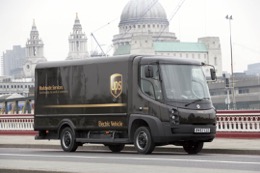
Another potentially overlooked issue is licences and drivers. As vehicles with longer ranges and bigger batteries are developed, they increase in weight. If vans exceed 3.5 tonnes, younger drivers require category C driving licences. Thompson-Sage says that is something to bear in mind.
Finance
The cost of electric vans is “cost-comparable” to internal combustion vehicles over a nine-year service life, says Thompson-Sage. But she says the first year is “very capex intensive; the upfront cost is significant”.
As a global corporation committed to decarbonising its fleet, UPS has the resources to manage those costs, says Thompson-Sage, but smaller companies may struggle to swallow them – especially if grid upgrades are also required.
Scale and share
Bringing down those costs is therefore key to decarbonising transport – and the broader economy. In that sense, working through the challenges and sharing learning is something UPS hopes will bring its own rewards.
“UPS has always had a very strong sustainable ethos and wants to be a leader in industry,” says Thompson-Sage. “Hence working with partners not just to provide solutions for UPS, but for the whole marketplace.”
Rather than altruism, she says that approach is good business sense.
“Scale brings the cost down for everybody, which is why we aim to develop solutions with partners and bring technology to market,” says Thompson-Sage.
“Our goals are not just reducing carbon emissions and increasing sustainability but improving air quality and helping to reduce congestions – because it is central to what we do.”
Smart charging: Overcoming grid constraints
UPS wanted to increase the number of EVs at its Camden base, but was limited by grid infrastructure. So it collaborated with distribution network operator UK Power Networks and consultancy Cross River Partnership on the Smart Electric Urban Logistics Project (SEUL), which commenced in April 2017 with government funding from OLEV.
The project designed and implemented a smart charging and energy storage system that takes into account variations in daily demand on the network.
Taking that approach meant UKPN could immediately add another 20 vehicles to the depot, which previously had charging capacity for a maximum of 52 vehicles. The system means it can now manage up 170 electric vehicles via its existing grid connection agreement, future proofing the site.
Taking a smart approach brings down capex. Without it, UPS would have had to increase its grid connection from 1,250kVA to 2,200kVA.
It can also reduce opex, because smart charging can take advantage of cheaper periods.
The system has the potential to provide other benefits, such as grid balancing services from the battery stack, should UPS wish to do so.
Further details here.
Sustainability goals
UPS has committed to make one in four new vehicles purchased by 2020 being an alternative fuel or advanced technology vehicle.
The company has also pledged to obtain 25 per cent of the electricity it consumes from renewable energy sources by 2025 and replace 40 per cent of all ground fuel with sources other than conventional petrol and diesel.
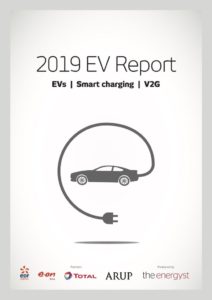 This article was published in The Energyst’s new 2019 EV Report.
This article was published in The Energyst’s new 2019 EV Report.
The report includes a survey of more than 100 businesses and details their EV and charging plans as well as attitudes to smart charging and vehicle-to-grid services.
It also contains interviews with other businesses switching fleets to EVs, charging point companies, distribution network operators, consultants, carmakers, technology firms and energy suppliers.
Download the report, free of charge, here.
Related stories:
Free report: EVs, smart charging and vehicle-to-grid
Oxford goes large on EVs, hybrid storage and heat pumps
Superchargers: Why the chicken crossed the road
WPD outlines EV numbers it can handle, connections and upgrade costs
EVs: Car parks sought for V2G trials
Nissan: 2019 will be “breakthrough year” for V2G, eyes energy retail market
Volkswagen: Carmaker to become energy company
Pubs and supermarkets the new petrol stations?
Chargepoint raises £189m to fund EV charging infrastructure
BT and Eon pledge to electrify fleet by 2030
Total partners with Chargepoint to bundle energy and EVs to businesses
Octopus backs flex and EVs for growth
Energy managers to become fleet managers
EV boom no sweat, says National Grid
Flexitricity chief: UK has enough spare power electrify every car on the road
Pivot makes huge play for 2GW storage and EV charging network
‘Land grab’ for EV car parks and revenue
National Grid predicts huge solar growth, while EVs create huge storage capacity
Follow us at @EnergystMedia. For regular bulletins, sign up for the free newsletter.

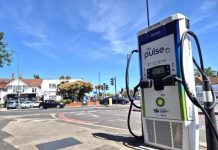

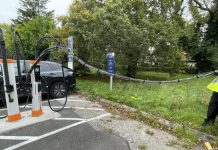
Does the big emissions reduction brag include the cost of disposing of the battery and the coal burn necessary to make a magic “plug” that gets energy out of the ether?